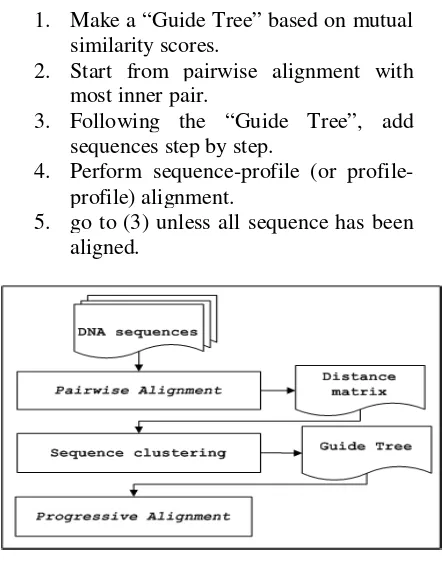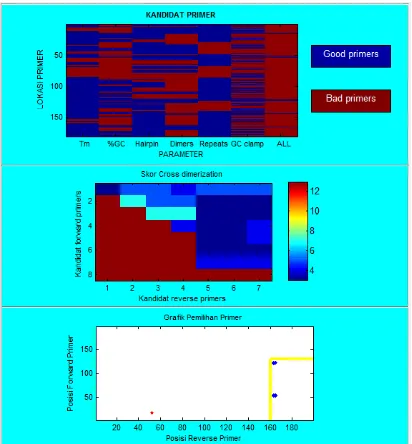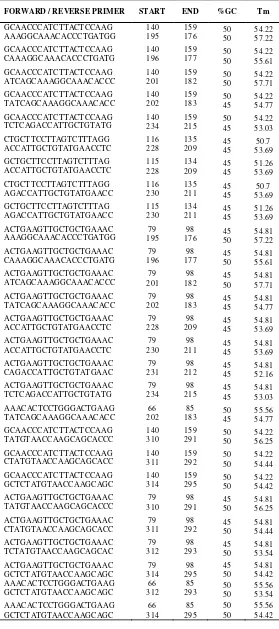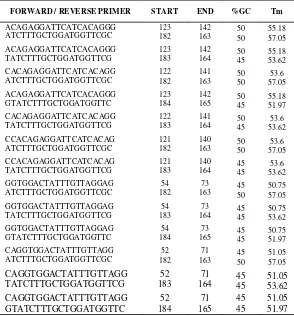39
DESIGN OF POTENTIAL CELLULASE PRIMER USING MULTIPLE
SEQUENCE ALIGNMENT METHOD
a
Bahrul Ulum,
bWisnu Ananta Kusuma,
cJoni Prasetyo
a,bDepartment of Computer Science, Bogor Agricultural University, Bogor, Indonesia a
Department of Informatics Engineering, Al-Kamal Institute of Science and Technology, Jakarta c
Renewable Energy Division, BPPT, Serpong, Indonesia E-mail: [email protected]
Abstrak
Selulase mempunyai peranan utama dalam pemanfaatan limbah biomassa yang mengandung lignin, hemicellulose, dan cellulose (lignocellulose). Limbah biomassa ini sangat banyak terdapat di lingkungan dan sampai saat ini masih belum dimanfaatkan secara maksimal, dikarenakan banyak mikroorganisme dari alam yang memproduksi enzim selulase dengan jumlah terbatas (aktifitasnya rendah). Dalam rangka meningkatkan produktivitas mikroorganisme untuk menghasilkan selulase, salah satu cara yang dapat diterapkan adalah merancang primer sekuens gen penyandi selulase yang dirangkum dari beberapa mikroorganisme penghasil selulase. Dalam penelitian ini, kami melakukan penyejajaran sekuen DNA penyandi selulase untuk mencari potensial primer untuk meningkatkan produktivitas enzim selulase dengan teknik Multiple Sequence Alignment (MSA). Metode yang digunakan adalah metode progresif (Progressive Alignment Algorithms). Hasil penelitian menunjukan bahwa pada tahap penyejajaran, didapatkan tiga daerah konservatif (conserved regions). Sedangkan pada tahap perancangan dengan beberapa parameter yang telah ditentukan didapatkan 46 pasang primer dari lima sekuen gen penyandi selulase yang didapat dari National Center for Biotechnology Information (NCBI).
Kata kunci: Selulase, Multiple Sequence Alignment, Perancangan Primer.
Abstract
The role of cellulase is very important in degrading cellulose which is abundant in the environment, such as in biomass waste that is containing lignin, hemicellulose, and cellulose. Biomass waste is abundant in the environment and is still not fully utilized, because many of the natural microorganisms that produce cellulase enzymesproduce the enzyme in a limited amount (have low activity). In order to improve the productivity of microorganisms in producing cellulase, one of the ways that can be applied is to design primer sequences of genes encoding cellulase summarized from several cellulase-producing microorganisms. In this research,we perform alignment of DNA sequences coding of cellulase to look for potential primer in order to increase the productivity of cellulase enzymes by Multiple Sequence Alignment (MSA) method. The method used is progressive (Progressive Alignment Algorithms). The results showed that in the alignment phase, three conserved regions were obtained. However, in the planning phase by using some predetermined parameters 46 pairs of primer sequences were obtained from five genes encoding cellulase taken from NCBI.
INTRODUCTION
The use of cellulase in Indonesia has been increasing, because cellulase is used for bioconversion of lignocellulosic materials into energy resources from renewable raw materials, due to the depletion of fossil fuel reserves available [1-2]. Moreover, cellulase is highly required in a variety of industries, especially industries with substantial use of cellulase such as the textile, pulp and paper, detergents, pharmacy, agriculture and food [3-4]. Various applications of cellulase make it potential to be produced in Indonesia. Right now, cellulases is generally imported. Cellulase can be produced by a group of bacteria, molds and yeasts. Microbe that is most commonly used is Trichoderma reesei
[5].
To yield cellulase enzyme, we need to perform a primer design. Primer is a strand of nucleic acid that functions as starting point to synthesize Deoxyribo Nucleic Acid (DNA). Primer designing can be done based on know DNA sequence or on protein sequence. If neither the targeted protein or the DNA sequence know to have closest relationship. One of the ways is to use multiple sequence alignment technique [6].
The multiple alignment of biological sequences has become an essential tool in computational molecular biology. It is used to find conserved regions and motifs in protein families, to detect the homology between new sequences and groups of sequences having an already known function and in a preliminary phase of protein structure prediction [7]. Multiple alignment is also extensively used in molecular evolutionary analysis [8].
The related research of multiple sequence alignment is still focusing on protein sequences [9]. Multiple sequence alignment is also applied on the study of in silico production of hyaluronidase leech (Hirudo medicinalis) in genetic engineering [10]. A wide range of algorithms has been investigated in multiple sequence alignment. This algorithm is generally classified into three categories according to their properties exact algorithms [11] progressive algorithms [12-13] and iterative algorithms [14].
One of the three alignment algorithms, progressive algorithm has the advantage of speed and simple sides. Moreover, the algorithm is quite sensitive as alignment
algorithm. Progressive alignment algorithms is an approach algorithms in finding sequence globally in multiple sequence alignment.
In this paper we propose to cellulase encoding DNA sequence via multiple sequence alignment technique with progressive alignment algorithm. Furthermore, the results of the alignment will be designed in order to get its potential primer.
SEQUENCE ALIGNMENT
The procedure of this research in general is divided into three parts, which are data preparation, MSA with progressive alignment algorithm and primer design cellulase. More details can be seen in Figure 1.
Figure 1. Flowchart of analysis procedure
Data Preparation
In this step, the data is retrieved from National Center for Biotechnology Information (NCBI) GenBank and the data format is set in fasta format.
Progressive Alignment Algorithm
In the second phase DNA data will be aligned using the progressive alignment algorithm. This algorithm is used to find the global sequence alignment of multiple sequences.
Conserved Region
Start
Data Preparation
MSA with progressive alignment algorithm
Primer Design
Progressive alignment methods use the dynamic programming method to build a multiple sequence alignment starting with the most related sequences and then progressively adding less related sequences or groups of sequences to the initial alignment [15-16]. Relationships among the sequences are modeled by an evolutionary tree where the outer branches or leaves are the sequences. The tree is based on pairwise comparisons of the sequences using one of the phylogenetic methods [17]. Progressive alignment algorithm is as follows:
1. Make a “Guide Tree” based on mutual similarity scores.
2. Start from pairwise alignment with most inner pair.
3. Following the “Guide Tree”, add sequences step by step.
4. Perform sequence-profile (or profile-profile) alignment.
5. go to (3) unless all sequence has been aligned.
Figure 2. Multiple sequences alignment by progressive alignment algorithm
Figure 3. Process progressive alignment algorithm
Primer Design
During last phase, the cellulase encoding DNA, that has been aligned via progressive alignment algorithm will be used to design a potential primer with a predetermined criteria / parameters. The parameters used in this research are as follow: primer length is 20 bp (base pair), primer composition must contain bases G and C with minimum percentage of 45% and maximum percentage of 55% and also melting Temperature (Tm) of minimum = 50oC and maximum of = 60oC. Theoretically (Tm) can be calculated using the formula [2 (A + T) + 4 (C + G)] [18]. The sequence does not form stable hairpins, does not self dimerize, does not cross dimerize with other primers in the reaction, and has a GC clamp at the 3' end of the primer [19]. Primer design aimed to obtain the balance between specificity and efficiency of amplification
.
RESULT AND DISCUSSION
In this research, we used DNA data coding for cellulase from eukaryotes organisms. The data is retrieved from NCBI GenBank and the data format is set in fasta format. More details can be seen in table 1.
The search of conserved region of the gene encoding cellulase was done by multiple sequence alignment using progressive alignment algorithm shown in Figure 2. Multiple Sequence Alignment was use to find the highest level of similarity between DNA sequences and homology between related DNA sequences coding for cellulases shown in Figure 4. In simple manual execution of the algorithm that show the step by step of execution describe in figure 3.
Table 1. Cellulase data encoding
ORGANISM ACCESION
NUMBER LENGTH
Solanum
lycopersicum NM_001247953 1895 bp
Triticum
aestivum AY091512 2196 bp
Arabidopsis
thaliana NM_124350 2360 bp Solanum
lycopersicum NM_001247933 1717 bp
Solanum
Figure 4. Phylogenetic tree from five cellulase sequence
Figure 5. Results from the alignment of cellulase sequence by progressive alignment algorithm
Table 2. Conserved region.
REGION POSITION SEQUENCES
1 862-1175
GACCACTCTTGTTGGGAGAGACCTGAGGATATGGACACCCCAAGAAGTGTGTA CAAAATTGACAAAAACACTCCTGGGACTGAAGTTGCTGCTGAAACTGCTGCTG CTCTCGCTGCTGCTTCCTTAGTCTTTAGGAAATGCAACCCATCTTACTCCAAGAT ACTAATCAAAAGGGCCATCAGGGTGTTTGCCTTTGCTGATAAGTATAGAGGTTC ATACAGCAATGGTCTGAGAAAAGTAGTGTGCCCATACTACTGCTCAGTTTCGG GATATGAGGATGAGCTGTTGTGGGGTGCTGCTTGGTTACATAGAGC
2 1567-1765
TGTGGTGGAGTTGTTATTACACCAAAGAGGCTTCGAAATGTAGCCAAAAAACA GGTGGACTATTTGTTAGGAGACAATCCACTAAAAATGTCATACATGGTGGGAT ATGGAGCAAGGTATCCACAGAGGATTCATCACAGGGGATCCTCATTACCCTCA GTCGCGAACCATCCAGCAAAGATACAATGCAGGGATGGTT
3 1790-1915
CACCAAACCCGAACGTACTAGTAGGGGCTGTGGTAGGTGGTCCTGATGAGCAT GATCGTTTCCCAGACGAGCGTTCAGATTACGAGCAATCTGAACCTGCCACTTAC ATTAATGCTCCACTTGTTG
From the analysis result of the alignment of DNA cellulase data encoding, the species who has the score or the highest similarity is
Solanum lycopersicum NM-001247953. The template used to design potential cellulase primer is the high similary region (conserved region) within Solanum lycopersicum NM-001247953 sequence. After that we will be able to know position the potential conserved
region primer. Conserved region was derived from the one with the highest similarity within the whole region, as shown in the histogram (Figure 5).
Figure 6. Result primer design from region 1
Figure 7. Result primer design from region 2
Based on Figure 6, we are able to known that after the selection the potential location of a good primer from conserved region 1 is positioned between 150 to 210 within the 313 bp sequence. The range of amplification primer selection is 5 '-> 3' = 0-169 and 3 '-> 5' = 170-313. The result of the primer designing from conserved region 1 is 28 primer bases, as shown in table 3.
Based on Figure 7, it can be seen that the location for good potensial primer of conserved region 2 after the selection is between position 50 and 130 from the 198 bp
length sequence. The amplification range of primer selection is 5 '-> 3' = 0-150 and 3 '-> 5' = 160 – 198. The result of the primer design from conserve 2 sequence is 13 primer bases, can be seen on Table 4.
Figure 8. Result primer design from region 3
Based on Figure 8, it is known after the selection the potential location of a good primer for conserved region 3 is positioned between 60 to 90 of 125 bp sequence lenght. The amplification range of primer selection is 5 '-> 3' = 0 – 120 and 3 '-> 5' = 80 – 125. The result of the designed obtained from the conserved region 3 is 5 primer pairs, as shown in Table 5.
CONCLUSION
Table 4. Primer from Conversed Region 2.
Table 5. Primer from Conserverd Region 3
REFERENCES
[1] T. Anindyawati, “Prospek enzim dan limbah lignoselulosa untuk produksi bioetanol,” BS, vol. 44, pp. 49-56, 2009.
[2] B. Joshi, R.M. Bhatt, Sharma D, Joshi J, Malla R, Lakshmaiah, and Sreerama, “Lignocellulosic ethanol production: Current practices and recent developments,” Biotechnology and Molecular Biology Review, vol. 6, pp. 172-182, 2011.
[3] Kuhad RC, Gupta R, and Singh A, “Microbial Cellulases and Their Industrial Applications,” Enzyme Research, vol. 2011, pp. 1-10, 2011.
[4] Mojsov K, “Microbial cellulases and their applications in textile processing,”
International Journal of Marketing and Technology, vol. 2, pp. 12-29, 2012.
[5] R.K. Sukumaran, R.R. Singhania, and A. Pandey, “Microbial cellulases – Production, applications and challenges,”
Journal of Scientific & Industrial Research, vol. 64, pp. 832-844, 2005.
[6] P.V. Lakshmi, A.A. Rao, and G.R. Sridhar, “An Efficient Progressive Alignment Algorithm for Multiple Sequence Alignment”, International Journal of Computer Science and Network Security, vol. 8, pp. 301-305, 2008.
[7] Gambin A, and Otto R, “Contextual Multiple Sequence Alignment,” Journal of Biomedicine and Biotechnology, vol. 2, pp. 124–131, 2005.
[8] T Kampke, M Kieninger, and N Mecklenburg, “Efficient primer design algorithms,” Bioinformatics, vol.17, pp. 214–225, 2001.
[9] R.C. Edgar, and S. Batzoglou, “Multiple sequence alignment,” Science Direct, vol. 16, pp.1-6, 2006.
[10] Djamil, “Studi in Silico Produksi Hyaluronidase Lintah (Hirudo Medicinalis) Secara Rekayasa Genetika,” M. Eng. Thesis, University of Indonesia, Depok, 2005.
[11] J. Stoye, V. Moulton, and A.W. Dress, “DCA: An efficient iplementation of the divide and conquer approach to simultaneous Multiple sequence Alignment,” Computer Applications in the Biosciences, vol.13, pp. 625-626, 1997.
[12] A. Loytynoja and N. Goldman, “An algorithm for progressive multiple alignment of sequences with insertions”, in Proceedings of The National Academy of Sciences of The United States of
America,vol. 102, pp. 10557–10562, 2005.
[13] D.W. Mount, “Using Progressive Methods for Global Multiple Sequence Alignment,” Cold Spring Harb Protoc, vol. 4, pp. 1-6, 2009.
[14] D. Lupyan, A.L. Macias, and A.R. Ortiz, “A new progressive-iterative algorithm for multiple structure alignment,”
Bioinformatics, vol. 21, pp. 3255-3263, 2005.
[15] J.D. Thompson, D.G. Higgins, and T.J. Gibson, “CLUSTAL W: Improving the sensitivity of progressive multiple sequence alignment through sequence weighting, position-specific gap penalties and weight matrix choice”, Nucleic Acids Res, vol. 22, pp.4673–4680, 1994.
[16] D.G. Higgins, J.D. Thompson, and T.J. Gibson, “Using CLUSTAL for multiple sequence alignments,” Methods Enzymol, vol. 266, pp. 383–402, 1996.
[17] D.W. Mount, “Distance methods for phylogenetic prediction,” Cold Spring Harb Protoc, vol.4, pp. 1-6, 2008.
[18] R.B Wallace., J. Shaffer, R.F.Murphy, J. Bonner, T. Hirose, and K. Itakura, “Hybridization of synthetic oligodeoxyribonucleotides to phi chi 174 DNA: the effect of single base pair mismatch,” Nucleic Acids Res, vol.6, pp.3543-3557, 1979.





